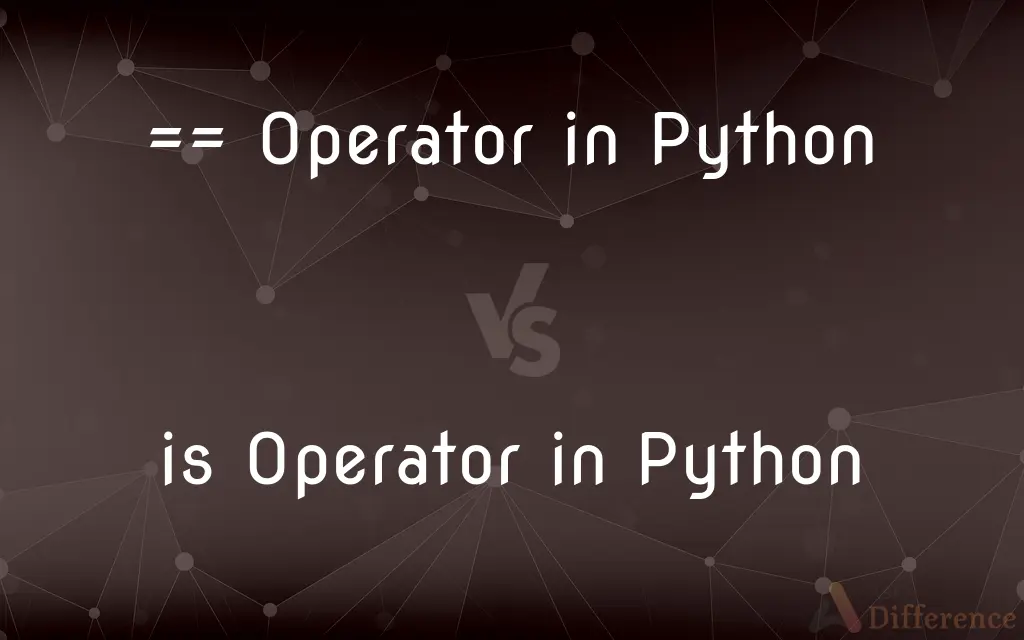== Operator in Python vs. is Operator in Python — What's the Difference?
By Tayyaba Rehman — Published on January 1, 2024
The == operator checks if two values are equal, while is checks if two variables refer to the same object in memory.

Difference Between == Operator in Python and is Operator in Python
Table of Contents
ADVERTISEMENT
Key Differences
The == operator in Python compares the values of two objects to determine if they are the same in content, disregarding whether they are the same instance. Conversely, the is operator checks for object identity, testing if both operands point to the same object in memory. Even if two separate objects have the same content, == will return True, but is will return False.
In Python, the == operator is used for value equality. It invokes the __eq__ method of an object, which can be overridden for user-defined classes. The is operator, on the other hand, cannot be overridden as it is designed to compare object identities, making it faster for this specific purpose than ==.
When using ==, Python compares the data contained in the objects, such as the sequence of characters in two strings or the items in two lists. With is, Python compares the memory addresses. Hence, two variables that are equal (==) may not necessarily be identical (is), especially for mutable objects.
Immutable objects in Python, like integers and strings, may have the same identity for certain values due to interning, which reuses the object instance. Thus, is and == may behave similarly for these types of objects but should not be used interchangeably. is is generally used for checking against None (e.g., if my_var is None:), whereas == is used for numerical and string comparisons.
Comparison Chart
Purpose
Checks value equality
Checks identity (same object in memory)
ADVERTISEMENT
Method Invoked
__eq__
None (direct memory address comparison)
Common Use
Comparing content of objects
Checking if two references are to the same object
Mutability Impact
Same value mutable objects are 'equal'
Same value mutable objects are not 'identical'
Performance
Can be slower for complex objects
Generally faster as it's a simple reference check
Compare with Definitions
== Operator in Python
Used for content comparison.
['a'] == ['a'] returns True.
is Operator in Python
Cannot be overridden.
A is b is strictly reference comparison.
== Operator in Python
Compares after type coercion.
5.0 == 5 returns True.
is Operator in Python
Indicates object identity.
A is a always returns True.
== Operator in Python
Evaluates to a boolean.
'Python' == 'python' returns False.
is Operator in Python
Checks if two references point to the same object.
A is b where a and b are references to the same object.
== Operator in Python
Checks equality of value.
5 == 5 returns True.
is Operator in Python
Used for comparison with None.
X is None checks if x is None.
== Operator in Python
Can be overridden.
Class A: pass a, b = A(), A() a == b depends on __eq__.
is Operator in Python
Quick reference check.
A is not b checks if a and b are different objects.
Common Curiosities
Should is be used to check for None?
Yes, it's the recommended way to check if a variable is None.
Can == be used for all objects?
Yes, == can be used for any objects that define the __eq__ method.
When should I use == in Python?
Use == when you need to compare the values of two objects for equality.
Can I override the behavior of is?
No, is behavior is fixed and cannot be overridden.
What does is compare in Python?
is compares the memory addresses of two objects to check if they're the same object.
Is is faster than ==?
Yes, is can be faster as it's a simple memory address comparison.
Are is and == interchangeable for None checks?
No, is is preferred for None checks due to clarity and reliability.
Is == reliable for floating-point comparison?
Due to precision issues, it's often better to compare floats using a tolerance.
Can is be used with literals?
Yes, but it's not meaningful as literals are created as new objects.
Can == give false positives?
If __eq__ is not implemented properly, it can lead to incorrect results.
Why might is be true for some strings or numbers?
Python might intern some immutable objects, so identical literals could refer to the same object.
How can I check if two lists are the same with ==?
If the lists contain the same elements in the same order, == will return True.
Can is return true for different objects?
No, is only returns true if both operands refer to the exact same object.
What happens if I compare two custom objects with ==?
The result depends on the __eq__ method implementation within the class of the objects.
Does == consider object type?
Yes, objects of different types are usually not equal unless compared types handle coercion.
Share Your Discovery

Previous Comparison
Styrofoam vs. Thermocol
Next Comparison
Frame vs. PacketAuthor Spotlight
Written by
Tayyaba RehmanTayyaba Rehman is a distinguished writer, currently serving as a primary contributor to askdifference.com. As a researcher in semantics and etymology, Tayyaba's passion for the complexity of languages and their distinctions has found a perfect home on the platform. Tayyaba delves into the intricacies of language, distinguishing between commonly confused words and phrases, thereby providing clarity for readers worldwide.
















































